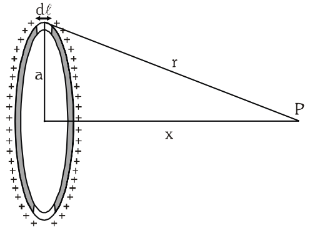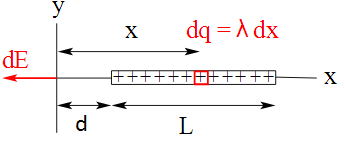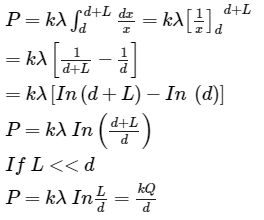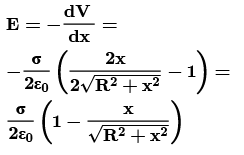JEE Exam > JEE Notes > Additional Study Material for JEE > Electric Potential of Uniformly Charged Ring, Rod, and Disc
Electric Potential of Uniformly Charged Ring, Rod, and Disc | Additional Study Material for JEE PDF Download
Electric Potential Due to a Charged Ring
Let electric potential at point P due to small element of length dℓ be dV.

(distance between small element and point P is equal to r)
Electric potential due to whole ring

Potential Due to a Uniformly Charged Rod
Electric Potential due to a uniformly charged rod of length L and linear charge density lambda, at a point P on its axial line which is d units away from it
Charge per unit length λ = Q/L
Charge of slice dq = λ.dx
Electric potential: 

Potential Due to a Uniformly Charged Disc
Find the electric potential at the axis of a uniformly charged disc and use potential to find the electric field at same point.

Potential due to ring element of radius r and thickness dr is dv:



The document Electric Potential of Uniformly Charged Ring, Rod, and Disc | Additional Study Material for JEE is a part of the JEE Course Additional Study Material for JEE.
All you need of JEE at this link: JEE
|
22 videos|162 docs|17 tests
|
FAQs on Electric Potential of Uniformly Charged Ring, Rod, and Disc - Additional Study Material for JEE
| 1. What is the electric potential of a uniformly charged ring? |  |
Ans. The electric potential of a uniformly charged ring at a point on its axis is given by the equation V = kQ/(√(R^2 + x^2)), where V is the electric potential, k is the electrostatic constant, Q is the charge of the ring, R is the radius of the ring, and x is the distance from the center of the ring to the point on its axis.
| 2. How is the electric potential of a uniformly charged rod calculated? |  |
Ans. The electric potential of a uniformly charged rod at a point on its perpendicular bisector is given by the equation V = (kλ/2πε) * ln((R + √(R^2 + d^2))/(R - √(R^2 + d^2))), where V is the electric potential, k is the electrostatic constant, λ is the linear charge density of the rod, ε is the permittivity of free space, R is the length of the rod, and d is the distance from the center of the rod to the point on its perpendicular bisector.
| 3. What is the electric potential of a uniformly charged disc at its center? |  |
Ans. The electric potential of a uniformly charged disc at its center is given by the equation V = (kσ/2ε) * (1 - √(2)), where V is the electric potential, k is the electrostatic constant, σ is the surface charge density of the disc, and ε is the permittivity of free space.
| 4. How does the electric potential of a uniformly charged ring vary along its axis? |  |
Ans. The electric potential of a uniformly charged ring decreases as the distance from the center of the ring to the point on its axis increases. It follows an inverse square law, where the electric potential is inversely proportional to the square root of the sum of the square of the distance and the square of the ring's radius.
| 5. What happens to the electric potential of a uniformly charged rod as the distance from its center increases? |  |
Ans. The electric potential of a uniformly charged rod decreases as the distance from its center increases. It follows a logarithmic relationship, where the electric potential decreases as the natural logarithm of the ratio of the sum of the length of the rod and the distance from its center to the difference of the length of the rod and the distance from its center.

|
Explore Courses for JEE exam
|

|
Signup for Free!
Signup to see your scores go up within 7 days! Learn & Practice with 1000+ FREE Notes, Videos & Tests.
Related Searches

















